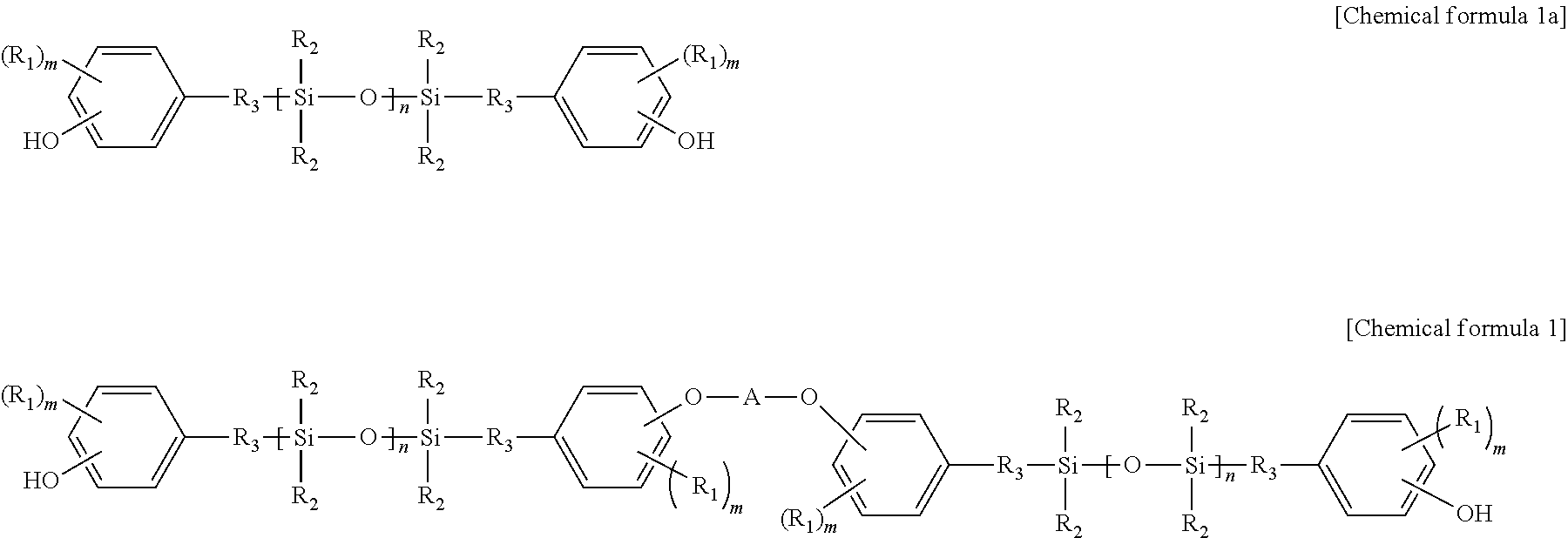Polysiloxane-polycarbonate copolymer and method of manufacturing the same
- Summary
- Abstract
- Description
- Claims
- Application Information
AI Technical Summary
Benefits of technology
Problems solved by technology
Method used
Image
Examples
example 2
[0067]
[0068]In a 100 mL three-necked flask equipped with a condenser, 0.03 mol of eugenol and 0.015 mol of polydimethylsiloxane were completely dissolved in 50 mL of chlorobenzene under nitrogen atmosphere, and then 0.00364 mmol of platinum catalyst (platinum(0)-1,3-divinyl-1,1,3,3-tetramethyldisiloxane complex) was added thereto. The resulting solution was then refluxed for 24 hours, and the solvent was removed therefrom. The product was washed with distilled water to obtain hydroxy-terminated siloxane of the following chemical formula 7 (Mn:8,044).
[0069]
[0070]An interfacial reaction of bisphenol A in an aqueous solution and phosgene gas was conducted in the presence of methylene chloride to prepare 400 mL of an oligomeric polycarbonate mixture having a viscosity average molecular weight of about 1,000. To the obtained oligomeric polycarbonate mixture, 4.5% by weight of the hydroxy-terminated siloxane having ester linkage of chemical formula 7 which was dissolved in methylene chlor...
example 3
[0071]The polysiloxane-polycarbonate copolymer was prepared by the same method as described in Example 2, except that the hydroxy-terminated siloxane (Mn: 12,141) having ester linkage of the following chemical formula 8 was prepared and used in an amount of 4.5% by weight. The physical properties of the prepared polysiloxane-polycarbonate copolymer were measured, and the results are shown in Table 1 below.
example 4
[0072]The polysiloxane-polycarbonate copolymer was prepared by the same method as described in Example 2, except that the hydroxy-terminated siloxane (Mn:7,000) having ester linkage of the following chemical formula 9 was prepared and was used in an amount of 4.5% by weight, and 2.6 g of p-tert-butylphenol (PTBP) was used. The physical properties of the prepared polysiloxane-polycarbonate copolymer were measured, and the results are shown in Table 1 below.
PUM
| Property | Measurement | Unit |
|---|---|---|
| Percent by mass | aaaaa | aaaaa |
| Weight | aaaaa | aaaaa |
| Molecular weight | aaaaa | aaaaa |
Abstract
Description
Claims
Application Information
 Login to View More
Login to View More - R&D
- Intellectual Property
- Life Sciences
- Materials
- Tech Scout
- Unparalleled Data Quality
- Higher Quality Content
- 60% Fewer Hallucinations
Browse by: Latest US Patents, China's latest patents, Technical Efficacy Thesaurus, Application Domain, Technology Topic, Popular Technical Reports.
© 2025 PatSnap. All rights reserved.Legal|Privacy policy|Modern Slavery Act Transparency Statement|Sitemap|About US| Contact US: help@patsnap.com



